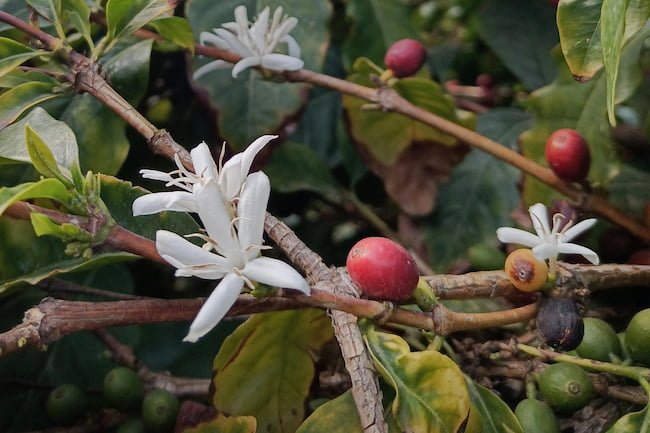From seed at the farm to that black beverage in your cup. That is the life journey of coffee.
But what goes on between the first and final stages?
This quick primer will cover everything you need to know about coffee production. From growing the beans to processing and roasting.
We’ll also examine the types of coffees available and explain why certain ones taste different (or better!) than others.
This short article will teach you everything you need to know about everybody’s favorite bean.
Step Zero: The Big Coffee Bang
Before we start, let’s briefly touch upon the coffee world’s version of the Adam & Eve story.
The main coffees we consume today are Arabica and Robusta.
Arabica is renowned as the flavorful and superior coffee type, while Robusta is usually reserved for cheap instant coffee and Italian espresso blends.
However, in reality, Robusta is one of the parents of Arabica.
It’s estimated that a spontaneous hybridization between Robusta and another wild coffee species, Coffea eugenioides, occurred relatively recently. These two coffee plants met somewhere in the Western part of Ethiopia and created Arabica together in what could be described as a “coffee big bang.”
Join me in this video and get feel for how coffee is grown at the farm 👇
This event was estimated to have occurred between 500.000 and 1 million years ago. However, new research points to a much later date, only around 10.000 years ago. (source)
This is pretty surprising and mindblowing when you consider that we – homo sapiens – have been around for at least 200.000 years.
Just imagine… even if our cave-dwelling ancestors wanted a cup of arabica coffee, they couldn’t because evolution hadn’t gotten around to the “coffee big bang” yet 🤯
The parents, Robusta and Eugenoides, are so dissimilar that they can’t be interbred in a lab. Therefore, we should consider ourselves extremely lucky that evolution (or some kind of god) created the Arabica plant that we can enjoy today.
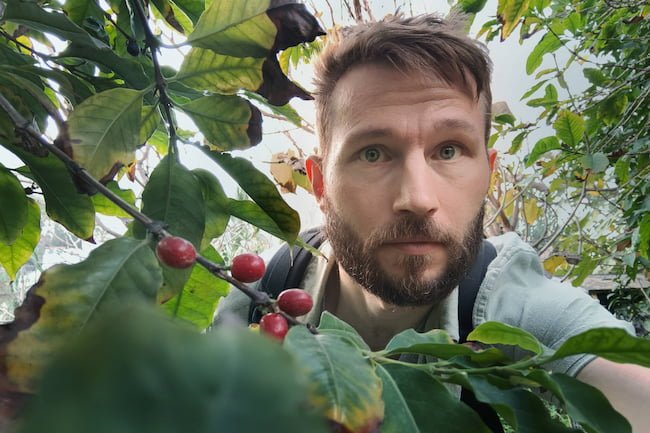
Planting Coffee
Coffee starts as a fruit seed.
That red cherry-looking thing you see in pictures of coffee farms; that’s the coffee fruit of the coffee tree.
What people call a “coffee bean” is the seed from a fruit that has been roasted.
The coffee seeds are usually planted in nurseries, where they develop into seedlings. When they have developed a robust root system, these seedlings are planted on the coffee farm.
Arabica coffee is indigenous to the mountainous forest regions of Ethiopia. That’s why the plant thrives in a tropical climate that mimics its original conditions.
For that reason, you’ll mostly see coffee grown on mountain slopes in countries around the Equator.
Harvesting Coffee
Usually, the coffee harvest takes place once a year, over a few months.
Colombia is the exception to this rule since there are typically two harvest periods.
The most common way to harvest is by hand-picking. This method is labor-intensive but high-quality since you can selectively pick the ripest cherries, usually easy to spot being dark red. Or, in some rare cases, yellow or even pink.

Another option is to use mechanical harvesters. They’re more efficient, but this type of farming is commonly associated with lower quality. This is because mechanical harvesters can only function well in farms where coffee is planted in neat rows on vertical land. Also, mechanical harvesters have a harder time discerning between ripe and unripe cherries.
Processing Coffee
After harvesting, the fruits are transported to processing facilities. There are different names depending on the country. They are sometimes called washing stations (Ethiopia) or coffee factories (Kenya).
There are three main ways to process coffee, and every method will add its unique flavor profile to the coffee.
- Wet processing involves floating the beans in water before depulping, fermenting, and washing.
- Dry processing means drying the beans in their skin right after picking them. This is often referred to as the natural process.
- Honey processing combines both steps mentioned above; the fruit skin is removed, but instead of washing the coffee, it’s directly dried. The mucilage is like a slimy, sticky layer that will stay on the outside of the beans. It can look a bit like honey, hence the name. No actual honey is involved in the honey process!
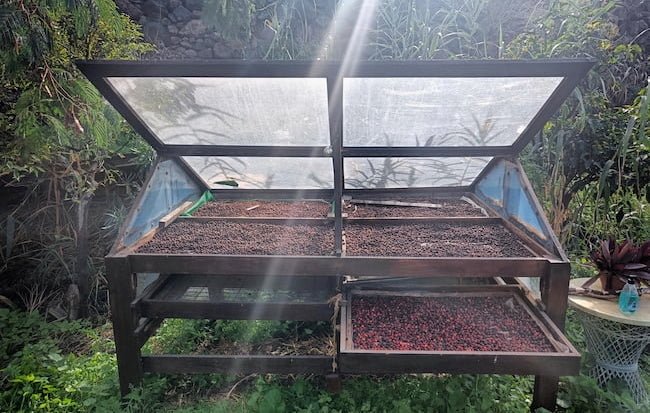
Drying the Beans
After processing, the beans must be dried to approximately 11 percent moisture before they’re ready for export.
The beans still have an outer protection layer called “parchment” that will stay inside in this drying phase. There are different ways of drying parchment coffee, but it’s common to sun dry it on concrete floors.
Milling the Beans
The next step is hulling; this refers to removing the parchment layer (a kind of protective skin outside the seed) if the coffee has been wet-processed.
If the coffee has been dry (aka natural) processed, this step also refers to removing the dried husk/fruit skin.
When the parchment has been removed, we have what coffee roasters call “the green bean.” This tiny seed doesn’t look that green in the strictest sense; it’s more of a pale grey with a green, yellow or blue tint.
At some coffee mills, there will also be a polishing step, where a thin layer named silverskin is removed from the green bean.
Next, the beans are sorted by size to facilitate even roasting. Generally, larger beans command a higher price, though their size does not necessarily correlate with better taste.
For instance, Kenya AA refers to the largest bean size in the sorting screen but does not indicate the flavor profile.
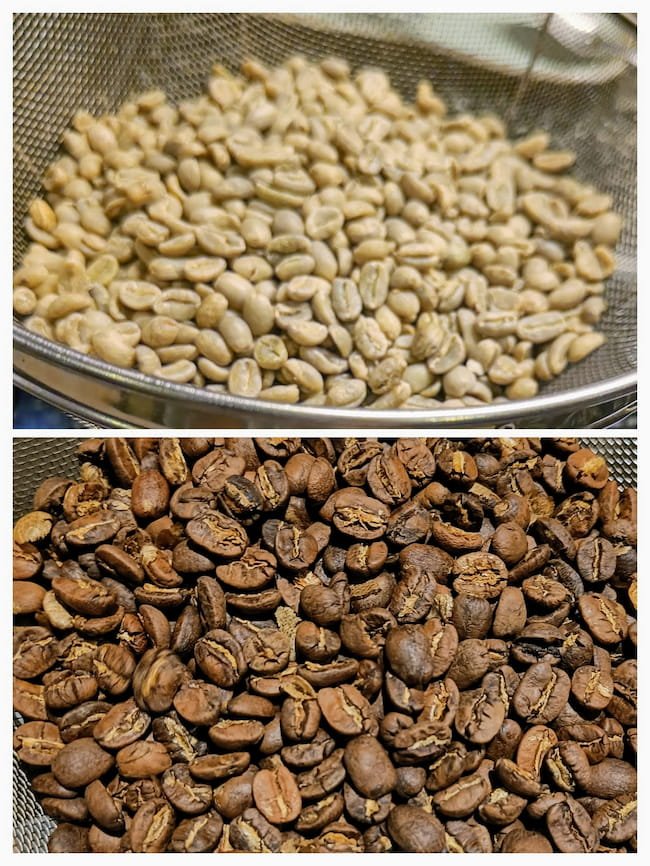
Exporting and Importing the Beans
At this stage, a big chunk of the coffee is packed in containers and shipped abroad.
A lot can be said about this step, but it’s mainly of interest if you work in the coffee industry. This is because coffee buyers usually place orders by sampling a range of beans beforehand.
However, there’s no guarantee that the product the buyer receives tastes the same as the one in the pre-order sample.
And since coffee is exported in big lots, enough to fill an entire container, importing it is not a trivial matter that should be left to amateurs. Instead, it’s a delicate undertaking that requires skills in diverse fields such as logistics, law, and green coffee evaluation.
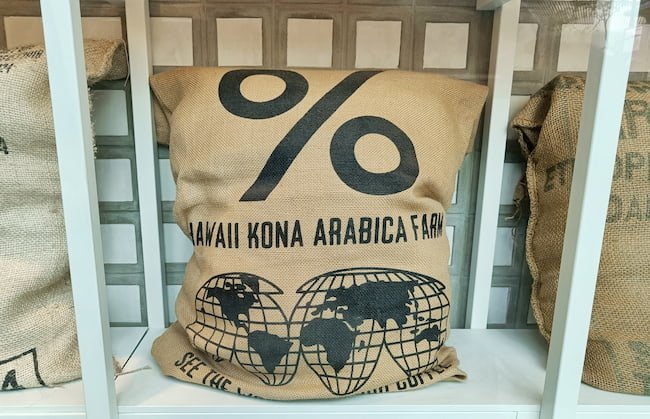
Each country also tends to have its own rules and regulations, increasing the complexity.
For this reason, dedicated coffee importers play a vital role. Even though the specialty coffee sector sometimes scorns this kind of middleman, they play an essential role in the industry.
Direct trade is often lauded, but the reality is that most artisan roasters shouldn’t get involved in importing. Roasting coffee and running a café are different skills from importing an agricultural product.
Most coffee produced is eventually exported. However, many coffee-producing countries also have a robust domestic coffee culture. For instance, Brazil and Ethiopia are countries where the natives appreciate a fine locally-produced cup.
Roasting
Roasting is the step that transforms the green bean into the brown coffee bean that we all know and treasure. It’s a complex process that involves numerous variables.
The final color determines whether the coffee is light, medium, or dark roasted coffee.
But there is also the time in the roasting machine, the charge temperature, internal temperature, development time, rate of rise, etc. These things can also affect the final flavor profile.
The roastmaster will rely on software and thermocouples to keep track of all these parameters. The roast profile is often illustrated as a curve, where you have temperature and time on each axis. So one could say that roasting is equal parts craft, science, and culinary skill.
Of course, all this also depends on who is doing the roasting.
- Is it one of the big coffee companies available nationwide in the supermarket? Those brands tend to roast more for uniformity and consistent product.
- Is it a smaller artisan roaster?
- Or maybe even a home-roaster like myself? 😄 Yes, more and more coffee lovers take to roasting coffee at home. It’s a convenient and fun way to always have fresh coffee at hand.
There are different scales and levels of roasting, and the goal can be different at each one.
Grinding
If you buy your beans whole, you’ll have to grind them before you brew them.
Much can be said about grinding coffee, and I have many reviews on this blog, where you can delve into different brands and models.

Of course, you can also buy pre-ground coffee, but I wouldn’t advise it. Once the coffee bean has been ground, staleness sets in much sooner.
If you invest in a proper burr grinder, you’ll get a much better result.
Grinding is both simple and complex at the same time. Read more about it here.
Brewing
The final stage of coffee production is the actual brewing. Again, this is something that can be super simple and down to earth or be elevated to a science.
At the most basic level, we have coffee beans crushed with mortar and pestle and steeped in hot water, and at the other end of the spectrum, there’s highly advanced espresso making.
I have a ton of resources on how to brew coffee the best way possible, so I highly encourage you to check those out for inspiration!
Faq
Coffee grows in many countries across the world. The geographical area where coffee grows is sometimes called the “bean belt.” It’s an imaginary belt that goes around the globe. It stretches approximately from the Tropic of Cancer in the north to the Tropic of Capricorn in the south.
Wild coffee actually grows in many countries across Africa. However, the two main types that make up 99% of the world market, Arabica, and Robusta, are indigenous to Ethiopia and Uganda.
Arabica coffee most likely originated in the South-Western part of present-day Ethiopia. Despite the name, Arabica coffee does NOT come from the Arabian peninsula. However, Yemen was the first place where coffee was produced commercially, so the country played an important role in spreading coffee to the rest of the world.
